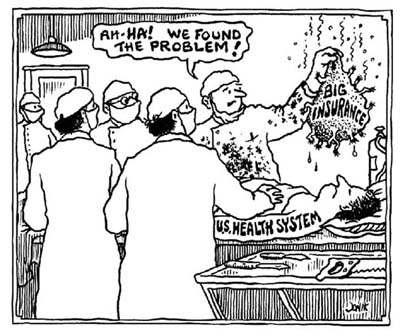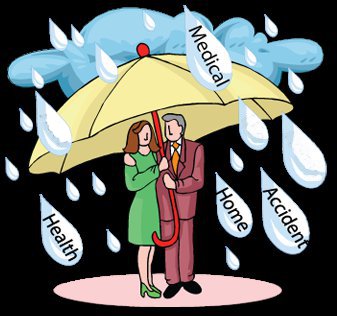Part 1: What Obamacare hopes to do
By Walter Sorochan
Posted July 24, updated October 12, 2021. Disclaimer
This article reviews Obamacare and the health-medical care controversy in an unbiased, independent, common sense manner and recognizes that Obamacare falls short in fixing the 'health care system'. It is researched and written in a simple manner so you, the reader, can understand the health-medical care system issues.
Introduction
That President Obama is trying to fix our medical care system is not breaking news, for many presidents have unsuccessfully tried to cure the ills. Such failures of the past, to reform a sick medical care system, illustrate the medical care problems and the complexity of such reform. Although the current Obamacare proposal may change with time, this article deals with the current legislation of 2010-2012.
 President Obama and Obamacare:
This legislation is not really health-medical care reform;
instead it is an attempt to reform the health insurance system and bring
insurance corporations under control. This legislation overlooks comprehensive reform of
how medical doctors heal people. Remaking the entire health-medical care system is what is really needed!
Unfortunately, the debate about the current 'health care' reform is also shrouded with misinformation during an
election year. As a result, the American
public has been confused about just what this legislation is all about; mostly
because politicians have been spinning their vested interest versions of this
legislation.
President Obama and Obamacare:
This legislation is not really health-medical care reform;
instead it is an attempt to reform the health insurance system and bring
insurance corporations under control. This legislation overlooks comprehensive reform of
how medical doctors heal people. Remaking the entire health-medical care system is what is really needed!
Unfortunately, the debate about the current 'health care' reform is also shrouded with misinformation during an
election year. As a result, the American
public has been confused about just what this legislation is all about; mostly
because politicians have been spinning their vested interest versions of this
legislation.
Confusion about Obamacare has cast a controversy over the USA medical care system. Almost everyone agrees that our medical care system is broken and needs to be fixed. But there is disagreement on how to fix the current system. A lot of confusion stems from all the mass media misinformation, the political bias and lack of focus on the really important and relevant issues about health care. Wiki: amacare act 2012 Most of the confusion comes from lack of honest information.
The Problem:
As of 2011, nearly 50 million people living in America did not have any medical insurance, and many millions more have inadequate coverage, leaving both their health and financial security highly vulnerable. As currently structured, the American medical care system is all too often inaccessible, unaffordable, inefficient, wasteful, uncoordinated and administratively complex. The major problem is how best provide affordable medical care insurance to all the people?
Economists argue that since the high cost of medical care is not improving the health of people and the private insurance market is unable to contain costs, that government intervention is justified. President Obama's legislation of 2010 attempts to contain costs and provide provide medical care coverage for everyone.
Obamacare is a political term for Patient Protection and Affordable Care Act, [ PPACA ] H.R.3590, passed in 2010. The Supreme Court of the United States (SCOTUS), on June 28th, 2012, released the ruling on President Obama's health care law and found the law to be largely constitutional with the individual mandate to purchase health insurance being classified as a tax. Nate: Supreme Court decision 2012 Other details of the act are summarized as: Wiki: Obamacare act 2012 Obamacare 2012
It is not just Obamacare that will confuse you; it is also the political arguments and mass media reporting that distort the real aspects of medical care. It is the messy details that make you loose your focus! So the first thing we need to do is simplify what Obamacare is and what it will do.
 To begin with Obamacare appears to be identifying the problem as an health insurance crisis
and not as a health-medical care system crisis. Too many
are uninsured or under-insured leading to massive unnecessary death and poverty.
It is on this basis that the government is acting since the private insurance industry
has failed miserably to either cover all or put the brakes on increasing costs.
Interestingly enough when HMOs were created in the 1970s this is what they
pledged to do. It has not happened.
To begin with Obamacare appears to be identifying the problem as an health insurance crisis
and not as a health-medical care system crisis. Too many
are uninsured or under-insured leading to massive unnecessary death and poverty.
It is on this basis that the government is acting since the private insurance industry
has failed miserably to either cover all or put the brakes on increasing costs.
Interestingly enough when HMOs were created in the 1970s this is what they
pledged to do. It has not happened.
What else does Obamacare propose? Here is a brief glimpse of H.R.3590: Years of planning, meetings, demonstration projects and so on while we continue as we are!
No reference is made in Patient Protection and Affordable Care Act, [ PPACA ] H.R.3590, to reform the many subsidies in farming that are suspected of contributing to chronic diseases and poor health. An attempt is made to require some transparency in the FDA, as in requiring limited labeling on food products. Carrying out childhood obesity demonstration projects is not directly attacking the already known issues related to obesity. Instead of enacting better anti-toxic environmental laws, Obamacare is going to provide more medicare coverage for certain individuals exposed to environmental health hazards. Obamacare will develop a plan for promoting healthy lifestyles and chronic disease self-management for Medicare beneficiaries; evaluate community prevention and wellness programs that have demonstrated a potential to help Medicare beneficiaries reduce their risk of disease, disability, and injury by making healthy lifestyle choices. But non-medicare persons appear to be overlooked! No mention of cultural reinforcements to help individuals adopt good life style habits. And Obamacare will allow the broken medical care system house to wrought! Obamacare: Original Bill 2011 How long will we have to wait for all these mandates to hatch and fix the medical care system?
President Obama briefly presents his version of Obamacare:
President Obama on Obamacare U-Tube 2012:
Source: Obamacare:
Obamacare: U-tube 2012
Beginning in 2014, Americans will be required to buy government-approved, private medical insurance or else pay a penalty.
Medical insurance companies will be required to spend on medical care at least 80% of the premium payments they receive from individual and small-group plans (and at least 85% from large group plans). The federal government will define what constitutes medical care.
Creating temporary high-risk pool with subsidized premiums for certain people with pre-existing conditions.
Imposing new taxes on some facilities, such as tanning parlors.
Medical insurers raised premiums for Americans as a direct result of President Obama's medical care overhaul.
Prohibit bans on pre-existing health conditions in children, lifetime and annual limits on expenses, and limits coverage exclusions of pre-existing health conditions in adults.
Requires family policies to include children up to age 26.
Does allow states to form compacts in order to allow the interstate sale of insurance.
Requires direct access to obstetrical and gynecological care, which might include abortion.
Creates (by 2014) medical insurance exchanges or marketplaces that will be state-based and state-administered, but states can opt out of this if certain conditions are met; insurance can be sold within the exchange only if government-approved, but insurance can be sold outside of the exchange.
Prohibits medical plans from discriminating against providers, but plans are not required to contract with any provider.
Requires employers having more than 50 full-time employees must provide medical insurance or pay a penalty.
Employees having 25 or less full-time employees and average salaries of $50,000 or less can apply for tax credits to provide medical insurance to their employees.
Medicaid - ObamaCare expands Medicaid (medical care for the poor) to everyone (under the Medicare age of 65) who has income less than 133% the federal poverty level. States must pay this enormous new burden, but federal government promises to reimburse costs of newly eligible patients under this program from 2014 to 2016.
Establishes a new Consumer Operated and Oriented Plan (CO-OP) program with the goal of creating non-profit, member-run medical insurance companies in every state
The above mandates confirm that Obamacare focuses on bringing medical insurance carriers under control.
Keep in mind that the above information is a summary. The summary assumes that your interpretation of the Obamacare is as intended by the wording of the legal act. Accepting a politician's point of view may be distorting the real truth ... especially when that politician is beholding to vested interest campaign handouts. However, you can view the details of the above summary and get lost and side-tracked in the details: Obamacare: Original Bill 2011
Politicians and Obamacare misuse the term 'health care' to mean medical care. This causes confusion as to what health care is really about. Health care is what you provide for yourself: proper diet, exercise, lifestyle, and so forth. Medical care is when you go to the hospital or medical doctor to receive help in times of emergency or acute need. Health care, as used by politicians, is implied to be medical care and labeled as Obamacare. This interplay of two different terms greatly adds to the confusion about Obamacare and medical reform.
Is Obamacare a good solution? Yes and No!
Obamacare is good because it provides universal - catastrophic medical care for everyone. It provides access to medical care for all. Obamacare recognizes the problem as a medical insurance crisis and not as a medical care system crisis. Obamacare is also good because it opens the door to further medical care system reform.
Obamacare is flawed [ not so good ] because it will not control expenditures and costs on a long term basis. It appears to defer fixing the other big health problems of people. Persons with faulty health habits will continuously get sick and need continuing expensive medical care. This is related to federal spending on treating the sick. Seventy percent of all medical expenditures in the United States are devoted to treating chronic disease; whereas only 4% of the healthcare budget is focused on primary prevention. Cohen: Making health care healthy 2010 Obamacare does not spell out the short-term reforms relevant to personal life style that would contain medical care costs. Jarvis: no hea care fix 2012
Overlooked in Obamacare are relevant health promotional incentives that would be supported by federal and state legislation. As long as government subsidies encourage farmers and health care providers to sell products and commodities that cause consumers to evolve unhealthy lifestyles, that, in turn, make them get sick and evolve chronic diseases, then the care and treatment of such anomalies will lack quality assurance and be out of control. Obamacare focuses on providing symptomatic care for the sick. It does nothing to have medical doctors focus on the cause of diseases and disorders. The real contributing causes of illness and disease, illustrated below, are overlooked!

Source: Walter Sorochan
Roughly 20 percent of patients in the United States have serious chronic illnesses such as diabetes, heart disease, and high blood pressure—conditions that in many people can be prevented or controlled with proper nutrition and exercise—and that 20 percent of the diseased persons account for 80 percent of health care spending. O'Brien: overtreatment causing costs Lubitz: Longevity and Medicare expenditures 1995 Obamacare does not look into what are the causes of chronic diseases; it somewhat side-steps dealing with where the spending is greatest.
Another big expense problem lacking a fix are senior citizen health problems. The most expensive age group for health care is senior citizens. Personal health expenditure rises sharply with age within the Medicare population. The oldest group (85+) consumes three times as much health care per person as those 65–74, and twice as much as those 75–84. Alemayehu: Lifetime hea care costs 2004 Instead of taking some personal responsibility for their health and lifestyle choices, seniors engage doctors in heroic efforts to keep them alive with tubes up their noses after they’ve become flaccid and bloated from a lifetime of bad habits. Although Obamacare provides medical care for the elderly, it is very skimpy in creating economic/social incentives for seniors and their relatives to contain medical costs.
Overhauling the U.S. medical insurance system, as attempted initially by President Obama, will do absolutely nothing to improve the health of the population. American medicine is extremely good for acute problems and diseases and dealing with emergencies and surgeries, but when it comes to health maintenance [ health promotion ], it’s next to useless.
It is also the issues related to the medical-health care system and the role of government in the medical care system that stir the debate about Obamacare. A major issue in medical care reform is the role of government in a society; whether government financed and regulated medical care is better than private funded medical insurance? This issue has been made worse by vested interest politicians protecting their turf or beliefs and forcing their 'fear' perception of the role of government on the public! Lack of political objectivity and transparency muddies the waters of medical care! Hence utter confusion! So what is the role of government in a society?
Government function in society:
Simply put, a government should make it possible for everyone, citizens and businesses, to function so everyone in society prospers and stays healthy.
The government should provide a floor of opportunity for persons to function, as in the illustration below. The government floor should be limited to provide an equal playing field but not to obstruct or handicap participants. Doing so creates a free enterprise system. This would be an ideal function of government. In the illustration below, the government has overstepped its role by providing a floor that is a muddy and slippery surface and the area for movement is regulated by the ring around the floor. But there are no fight rules about how to fight in the arena. The two combatants, from the private free enterprise sector, are using different rules for fighting. The fighter on the left uses a red glove barrier to gain an advantage while the combatant on the right uses kick boxing. Obviously there is no equal playing field in this illustration. Who is going to create a more equal playing field for both combatants? Who is going to police the boxing event? Should it be the government, the promoters of the boxing event, the combatants themselves or the spectators? Someone needs to referee or monitor the proceedings in the ring.

Does government have a role in a free enterprise system? The obvious answer is yes! The government’s roles would be appropriately limited to those of rule maker, fair referee, enforcer, and safety net of last resort. Unfortunately, what should be a common sense role is made worse by elected and corrupt politicians.
Equal playing fields:
 Politicians try to set the role of government and free medical care market enterprise with all
sorts of preconceived regulations and barriers in attempts to create a paying field
and how a free medical care market should function.
And so it is with the medical care system that the USA government initially
legislated over 100 years ago.
Stein: 100 years of US heacare 2010
Kelton: Hea care crisis 2007
Instead of creating an equal playing field, the government
in the past distorted the medical market in favor of providers. So
what are the features of a good medical care system?
Politicians try to set the role of government and free medical care market enterprise with all
sorts of preconceived regulations and barriers in attempts to create a paying field
and how a free medical care market should function.
And so it is with the medical care system that the USA government initially
legislated over 100 years ago.
Stein: 100 years of US heacare 2010
Kelton: Hea care crisis 2007
Instead of creating an equal playing field, the government
in the past distorted the medical market in favor of providers. So
what are the features of a good medical care system?
What is a good medical care system?
A few guiding principles about the best medical care systems: Sorochan: best hea care sys
1. There is no single best medical-health care system in the world
2. Need to look at the total population of a country and not at a few disgruntled individuals
3. Each medical care system is unique to its culture
4. Medical care system is based on spending and is often covered under the umbrella of social welfare, retirement, old age pensions, as well as research, public health, health care and so on
5. Medical care systems in each country are going to be in a constant state of flux and change; best systems adapt to the cultural values, the economy of the times, and so on
6. Medical care systems are based on expertise that is not politically or economically determined
7. Medical care systems do not allow anyone to make profit on sick or disabled or indigent people
8. Portability or allow coverage to follow person from job to job & location to location
9.9. The most economic systems are those that have a single payor provider for the medical care and options for additional minor ones
10. The argument that a medical care system may be socialized medicine or free enterprise is childish and uninformed.
11. Most medical care systems are based on the pocket book
12. Medical care systems are evolved with social justice in mind:
- The group is more important than the individual [ this is not socialized medicine ]
- Universal coverage for all [ everyone is covered ]
- Comprehensive coverage [for all disorders, diseases, dental, mental illnesses, etc..]
- Variety of treatment options [ emergency rooms, hospice, elderly care, baby sitting care, retirement homes, public health, occupational health, emergency room, ]
- economic incentives for everyone so as to keep costs down
- No one makes a profit on sick people
- Medical care is a right of everyone
- Priorities of who gets medical care first [ e.g. children and pregnant women or health middle agers ]
- Choice: everyone has same choice of doctors and care
- Economic incentives for doctors to provide better medical care [ bonus for fewer smokers, less obesity, exercising, lower blood pressure, etc. ]
Now you and others can disagree on these principles. Doing so is like shopping for an automobile while choking on emitted auto pollution and then buying and driving a polluting car. This shows lack of common sense for expertise knowledge [ such as Gerard Anderson, professor at John Hopkins School of Medicine and a leading expert on international comparisons and the Lewin Group Collins: Lewin Analysis Hea care bills 2009, prestigious analysts of medical socio-economics ], who have shown that changing to the Canadian health-medical care system would save appreciable money and help balance the federal budget.
A good medical care system focuses on two issues: affordable medical care and quality of care for everyone. To bring clarity to these issues, we need to define these terms.
 Affordable medical care includes universal
medical care coverage for everyone
at the lowest cost. One information source states that the cost of health
insurance for an average family of four in United States in 2012 is over
$20,000 a year.
Terhune: Hea Care costs equal new car 2012
Auerbach: Heacare costs per family 2011
The major reason this medical insurance coverage is so expensive is because it
provides for catastrophic illnesses and comes from insurance carriers that have very few members.
The way to bring this cost down is to get an insurance plan from an insurance carrier that has
a large number of people in its pool. The larger the pool, the lesser the
medical care cost. Having a single payer insurance carrier with a large number of persons greatly lowers
the affordability of medical care. A single payer system allows access
for all, is usually sponsored by a government and allows an integrated
system of regulated private insurance providers. Hyde also argues that
medical insurance works according to the Pareto Principle, more commonly known as the 80/20 rule.
At any given time, about 20% of the people consume 80% of the medical care. Insurance premiums from the healthy 80% offset the medical care of the sick 20%.
This is illustrated by examples in the
table below. United States is the only country without a national medical care
system.
Affordable medical care includes universal
medical care coverage for everyone
at the lowest cost. One information source states that the cost of health
insurance for an average family of four in United States in 2012 is over
$20,000 a year.
Terhune: Hea Care costs equal new car 2012
Auerbach: Heacare costs per family 2011
The major reason this medical insurance coverage is so expensive is because it
provides for catastrophic illnesses and comes from insurance carriers that have very few members.
The way to bring this cost down is to get an insurance plan from an insurance carrier that has
a large number of people in its pool. The larger the pool, the lesser the
medical care cost. Having a single payer insurance carrier with a large number of persons greatly lowers
the affordability of medical care. A single payer system allows access
for all, is usually sponsored by a government and allows an integrated
system of regulated private insurance providers. Hyde also argues that
medical insurance works according to the Pareto Principle, more commonly known as the 80/20 rule.
At any given time, about 20% of the people consume 80% of the medical care. Insurance premiums from the healthy 80% offset the medical care of the sick 20%.
This is illustrated by examples in the
table below. United States is the only country without a national medical care
system.
What is a single payer system? The video below explains this system:
source: Single Payer System
A single payer system usually requires everyone to buy insurance. Compulsory insurance isn’t exactly a radical concept. Most states require auto insurance because it’s the best way to make people responsible for the damage they can do behind the wheel. But the opposition has turned the battle against the individual mandate into a matter of truth, justice and the unalienable right to not purchase medical insurance and let the taxpayers pick up the free-rider’s emergency room bills. Those against Obamacare also try to discredit the mandate by labeling the mandate as socialism. This is not any more a socialist procedure than requiring auto insurance, that all auto drivers pass a driver's test or legislating that all drinking water be purified. These are ways of protecting the public from being ripped off by no-medical insurance free-riders.
Quality of Medical Care: This is also referred to as Quality Assurance. Quality health includes the amount and kind of medical care: primary care, hospital stay, doctor visits, treatment for diseases and disorders, medical care for all aged persons, public health services like sanitation and safe drinking water and so on.
In the contentious debate about medical care reform, the U.S. system is often compared to other systems around the world. Some are concerned that the U.S. spends twice as much per person as other rich countries but gets less quality care. Such debates center on whether the benefits should apply to the individual or the good of the mass public.
The table, now no longer active by Kaiser Permanente below, has been simplified from the original number of countries and health indicators. It compares select eight health-medical indicators for USA and 14 other countries. The indicators were selected because they display information that helps to put quality assurance in prospective.
| Switzerland | France | Germany | Japan | Norway | Denmark | UK | Canada | Mexico | China | Uruguay | Australia | Chile |
|---|---|---|---|---|---|---|---|---|---|---|---|---|
| 7,639,961 | 65,312,249 | 81,471,834 | 126,475,664 | 4,691,849 | 5,529,888 | 62,698,362 | 34,030,589 | 113,724,226 | 1,336,718,015 | 3,308,535 | 21,766,711 | 16,888,760 |
| 4.08 | 3.29 | 3.54 | 2.78 | 3.52 | 4.24 | 4.62 | 4.92 | 17.29 | 16.06 | 9.69 | 4.61 | 7.34 |
| 100% | 100% | 100% | 100% | 100% | 100% | 100% | 100% | 96% | 91% | 100% | 100% | 96% |
| 100% | 100% | 100% | 100% | 100% | 100% | 100% | 100% | 96% | 91% | 100% | 100% | 96% |
| $45,224 | $33,674 | $36,338 | $32,418 | $56,214 | $37,720 | $35,155 | $37,808 | $14,258 | $6,828 | $13,189 | $39,539 | $14,311 |
| $3,795 | $3,093 | $3,243 | $2,507 | $4,502 | $3,695 | $2,893 | $3,047 | $445 | $182 | $718 | $2,369 | $576 |
| 19.9% | 16.3% | 18.7% | 18.4% | 17.4% | 16.8% | 16.0% | 18.1% | 11.9% | 12.1% | 20.2% | 16.8% | 16.2% |
| 21% | 8% | 22% | 1% | 13% | 8% | 26% | 26% | 41% | 4% | 30% | 29% | 39% |
Limitations of data in above table: Data source The Kaiser Family Foundation Article & table by Kaiser: Customized health data 2011 is no longer active. Health indicators let you measure, monitor, and compare important factors that influence the health of people and the medical care system. Data are for 2009. The basic indicators of health-medical care for different countries often have no common denominator or thread, making it difficult to compare medical care systems. For example, the year data that is gathered and made available can differ from country to country. There is no "gold standard" for health by which to measure health quality. One way to deal with a lack of a gold standard for measuring quality of health is to use medical and health indicators that imply quality of health. The indicators in the above table, respected by WHO, help us to interpret how good a health care system is. Table created by Walter Sorochan.
For example, female prevalence of obesity represents lifestyle habits that also reflect on eating habits, cigarette smoking and exercising.
The simplest and best indicators of basic performance in terms of health and cost are life expectancy at birth, infant mortality rate and the cost measured relative to national wealth or % GDP.
Infant Mortality Rate, IMR, in the table tells us that our medical care system is not as good as that of other rich countries. Even the quality of our public health, % of population with access to drinking water and % of population with access to good sanitation, both 99%, is not as good as that of many other countries. We spend more for health per capita, $ 3049, and $45,989 of Gross Development Product or GPD, than many other countries. Our government spends more of total government budget on our medical care system, 19.6%, than most other countries. Our consumers of health, the general public, have bad lifestyles, as reflected in the highest percent of female obesity, 48%, in the world. There are many government laws that allow people to have bad lifestyle habits that contribute to the epidemic of obesity and other illnesses and diseases.
The conclusion from the information in this table is that our medical care system is not a good one, it is more expensive than it should be and that our government is not promoting positive lifestyles. It seems that making a profit from sick people is good business .
As everyone is aware, our political system has been dysfunctional for quite some time. Politicians have blocked reform of the medical care system. Thus, we need to fix a broken political system before we can really create a working cost effective medical care system [ fix a old medical care system ].
There are many aspects of the medical care system that can be changed to lower expenses. As of 2012, President Obama has not indicated what these are. But most of these easy fixes will be short-term, superficial and not bring medical expenditures under control nor fix the broken medical care house. The real reform will occur when long-term medical care system and personal health behaviors are brought under control; as discussed in Part 2: Cost effective ways to fix USA medical care system. Americans should expect to wait many, many years before the current medical health care system is fixed!
References:
Alemayehu Berhanu and Kenneth E Warner, "The Lifetime Distribution of Health Care Costs," Health Serv Res. 2004 June; 39(3): 627–642. Alemayehu: Lifetime hea care costs 2004
The distribution of health care costs is strongly age dependent, a phenomenon that takes on increasing relevance as the baby boom generation ages. After the first year of life, health care costs are lowest for children, rise slowly throughout adult life, and increase exponentially after age 50 (Meerding et al. 1998). Bradford and Max (1996) determined that annual costs for the elderly are approximately four to five times those of people in their early teens. Personal health expenditure also rises sharply with age within the Medicare population. The oldest group (85+) consumes three times as much health care per person as those 65–74, and twice as much as those 75–84 (Fuchs 1998). Nursing home and short-stay hospital use also increases with age, especially for older adults (Liang et al. 1996).
Anderson Gerard, "Chronic Conditions: Making the Case for Ongoing Care," Harvard School of medicine, November 2007. Article by Anderson: Medical economics 2007 is not active.
Anderson Gerard F. and David A. Squires, "Measuring the U.S. Health Care System: A Cross-National Comparison," The Commonwealth Fund, Issues in International Health Policy, June 2010. Article by Andersen: Measuring US hea care sys 2010 is no longer active
Auerbach D. I. and A. L. Kellermann, “A Decade of Health Care Cost Growth Has Wiped Out Real Income Gains for an Average US Family,” Health Affairs, Vol. 30, No. 9, September 2011. $ 17, 040 Article by Auerbach: Heacare costs per family 2011 is no longer active
Budetti Peter P., "Market Justice and US Health Care," JAMA, January 2, 2008—Vol 299, No. 1. Article by Budetti: Market justice in US Hea Care 2008, is no longer active.
Cohen Gary, "Making health care healthy," Social Entrepreneurs What Matters, April 6, 2010. Article by Cohen: Making health care healthy 2010, is no longer active. Seventy percent of all health expenditures in the United States are, devoted to treating chronic disease; only 4% of the healthcare budget is focused on primary prevention.
Collins Sara R., Ph.D, Jennifer L. Nicholson, and Sheila D. Rustgi, "An Analysis of Leading Congressional Health Care Bills, 2007-2008: Part I, Insurance Coverage," The Commonwealth Fund, January 9, 2009 | Volume 102. Collins: Lewin Analysis Hea care bills 2009
"Using analysis from the Lewin Group, the authors provide coverage and cost estimates for the proposed bills, which range from 48.9 million uninsured people gaining coverage to a net loss of coverage for 283,000 people; proposals could increase national health spending by as much as $64.1 billion or create savings of $58.1 billion."
Cutler David M., "TESTIMONY OF DAVID M. CUTLER Before the Committee on the Budget United States Senate," February 29, 2012. Otto Eckstein Professor of Applied Economics, Harvard University Article by Cutler: Containing hea care costs 2012, no longer active.
Friedman Gerald, "Funding a National Single-Payer System," Dollars and Sense,: Physicians for a National health care program, March/April 2012. Freidman: Physicians support National hea care 2012
“Medicare for All” would save billions, and could be distributive. While providing superior health care, a single-payer system would save as much as $570 billion now wasted on administrative overhead and monopoly profits. A single-payer system would also make health care financing dramatically more progressive by replacing fixed, income-invariant health care expenditures with progressive taxes. This series of charts and graphs shows why we need a single-payer system and how it could be funded.
Giles Allen, "What makes a good healthcare system?: comparisons, values, drivers," Radcliff Medical Press, United Kingdom, 2003. Article by Giles: what is good hea care, no longer active.
Houchens Paul R., "Measuring the strength of the individual mandate," Millman Research Report, March, 2012. Article by Houchens: Flaws in Obamacare 2012, no longer active.
Hyde Stephen, "The proper role of government in health care reform -- Part I: Market failure," Hyde on Health Care, November 12, 2009. Article by Hyde: govt role in health care 2009, is no longer active.
Kaiser Family Foundation, "US Global Health Policy, Customized Data Sheet," Kaiser: Customized health data 2011
Langley obert, "Should the US adopt a nationalized health care system?" Thought Co, October 05, 2021. Langley: Adopt Natioanalized Hea care system 2021
Lubitz J, Beebe J, Baker C., "Longevity and Medicare expenditures," N Engl J Med. 1995 Apr 13;332(15):999-1003. Lubitz: Longevity and Medicare expenditures 1995
Nate, "Supreme Court upholds ObamaCare mandate as a "tax" in 5-4 decision," 2012 Election central, June 28th, 2012. Article by Nate: Supreme Court decision 2012, is no longer active.
Obamacare, "Bill Summary & Status 111th Congress (2009 - 2010) H.R.3590 All Information," The Library of Congress Thomas Article & bill Obamacare: Original Bill 2011, are no longer available.
Obamacare, "Patient Protection and Affordable Care Act 2010 --- Basic Requirements," 2012. Obamacare 2012
Sorochan, Walter, "Basis for best health care systems:" Sorochan: best hea care sys
Steinreich Dale, "100 Years of Medical Robbery," Mises Daily: Thursday, June 10, 2004. Steinreich: brief history govt intervention 2004
Terhune Chad, "Average annual healthcare cost for a family tops $20,000," Los Angeles Times, May 15, 2012 Terhune: Hea Care costs equal new car 2012
Wikipedia, "Health care reform debate in United States." July 9, 2012. Wiki: hea care debate 2012
Wikipedia, "Health care reform in the United States." July 8, 2012. Wiki: Hea care reform in USA
Wikipedia, "Health insurance in the United States." Wiki: Hea insur in USA
Wikipedia, "Patient Protection and Affordable Care Act." July 9, 2012. Wiki: Obamacare act 2012